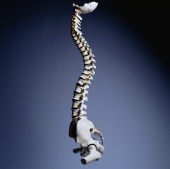
MONDAY, Jan. 31 (HealthDay News) — X-rays, CT scans and MRIs may be routinely ordered for people with low back pain, but often these tests are unnecessary, suggests new guidance from the American College of Physicians.
What’s more, these imaging tests have the potential to cause harm by exposing people to unnecessary radiation and by uncovering abnormalities — such as a bulging disc — that may not be causing the symptoms.
However, once such abnormalities are uncovered, they may be treated, potentially with an unneeded surgery, experts say.
And then there’s the matter of expense.
“Health-care costs are increasing unsustainably, and a crucial concern for everyone is how do we maintain or improve the quality of care without increasing costs? One way is for physicians to stop ordering tests that may not be beneficial,” said Dr. Amir Qaseem, one of the authors of the back pain guidelines, and director of clinical policy in the medical education division of the American College of Physicians (ACP) in Philadelphia.
The new guidelines on diagnostic imaging for people with low back pain are published in the Feb. 1 issue of the Annals of Internal Medicine.
Almost everyone will experience back pain at some point in their lives, according to the U.S. National Institute for Neurological Disorders and Stroke. The costs of treating low back pain are staggering: the ACP guidelines estimate that about $90 billion is spent each year in the United States on low back pain. In 1997, the average cost of treating one patient with back or neck problems averaged $4,795, according to the ACP. By 2005, that amount had climbed to $6,096.
Imaging tests make up a significant portion of those costs. The bill doesn’t only include the test, but follow-up that might occur afterward such as additional tests, referrals and additional treatments that sometimes include surgery.
Despite this increase in spending, the ACP cite data from six different studies that found that people with spine problems who got radiological tests had similar or worse scores on quality of life and physical functioning assessments a year later, compared to patients who went without the scans.
One of the reasons that the increased spending may not be improving outcomes is that most people with back pain will get better on their own — no matter what tests or interventions are done, the ACP experts said. In fact, they say, most people with acute back pain will begin to feel better within a month.
Overall, the results of X-rays, CT scans and the like rarely affect treatment plans, says the ACP, and if an abnormality is found on an imaging test, it can be difficult to know if that’s the cause of the symptoms or if it was always there.
For example, in one study of people over 60 who did not have any back pain, the ACP reports that 90 percent had either spinal disc degeneration or a bulging disc in their back, and another 21 percent had narrowing in their spinal canal.
“Essentially, using routine imaging is not benefiting patients and it may even be harmful, because it can lead to further unnecessary additional tests, perhaps invasive procedures and increased radiation,” said Qaseem.
So, what drives doctors to order these tests? Qaseem said there are a number of reasons. One is that physicians may feel that a patient expects a diagnostic test. Another is “defensive medicine,” when a doctor orders a test to be sure he or she hasn’t somehow missed an unusual condition. The wider availability of scanning technology may play a role, as may certain financial incentives, he said.
Dr. Anders Cohen, chief of neurosurgery and spine surgery at The Brooklyn Hospital Center in New York City, agreed that patient expectations and a concern about malpractice are significant contributors to the overuse of imaging for back pain.
“Back pain is one of the more poorly understood aspects of medicine, and diagnosing and treating low back pain can be a tricky diagnosis, even for people who do it full-time. But there does need to be some curtailing in the use of imaging, because diagnostic costs are getting out of control,” said Cohen.
However, both experts said that doctors can usually tell from a physical exam and someone’s description of their pain whether or not an imaging test is really necessary.
Both Cohen and Qaseem said that a better dialogue between patient and physician could go a long way in reducing the use of unnecessary imaging tests.
“Shared decision-making is really important. Most patients don’t want to get tests that aren’t beneficial, so it’s important to talk. Patients need to ask questions like, ‘If I do get this test, what are the benefits or harms?'” said Qaseem.
“We have a bountiful access to technology, but we don’t necessarily need all that stuff every time. The majority of back pain will get better without surgery. We need to empower patients, and let patients be a part of the process,” said Cohen.
More information
Read more about back pain from the U.S. National Institute of Neurological Disorders and Stroke.

